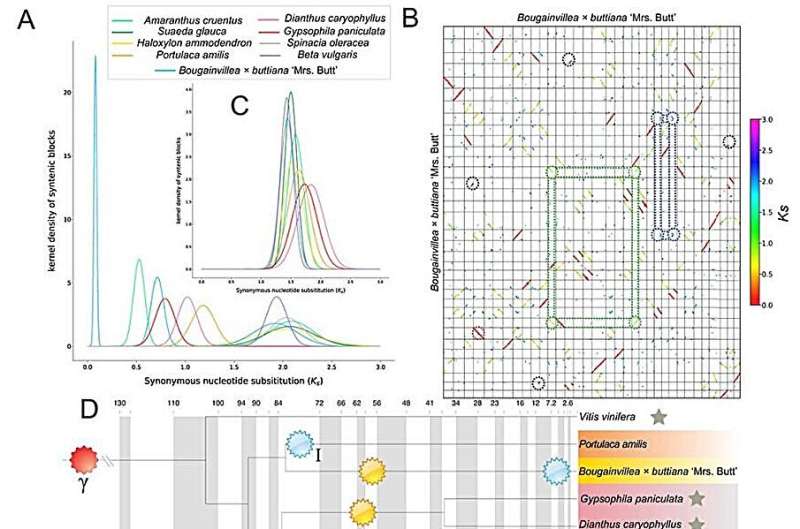This article has been reviewed according to Science X's editorial process and policies. Editors have highlighted the following attributes while ensuring the content's credibility:
fact-checked
peer-reviewed publication
proofread
A high-quality Bougainvillea genome helps to explore evolutionary history of a pigment biosynthetic pathway

Bougainvillea, a widely appreciated ornamental shrub, originates from South America and stands out due to its vibrant bract colors, which are believed to result from betalain accumulation. Although Bougainvillea has important ornamental and prophylactic value, the lack of genomic data has limited in-depth understanding of bract coloration and breeding pathways, and the relationship between betalain accumulation and Bougainvillea phenotypes had not yet been fully understood.
Therefore, an in-depth study of the effects of gene expression on on bract color is essential for more accurate prediction of plant breeding outcomes. In June 2023, Horticulture Research published a research paper titled "A high-quality Bougainvillea genome provides new insights into the evolutionary history and pigment biosynthetic pathways in the Caryophyllales."
The researchers utilized 65.37 Gb of HiFi data and 262 Gb of Hi-C data for genome assembly, resulting in a final BTFR genome size of approximately 5.1 Gb. The scaffold N50 was 151,756,278 bp and contained 86,572 genes.
By detecting a high percentage of duplicated gene sets (92.9%), suggesting recent whole genome duplication (WGD) events in BTFR. Comparative analysis indicated that the BTFR genome encompasses the highest repeat content among Caryophyllales genomes, mainly due to long terminal repeats (LTRs) which account for 59.7% of the BTFR genome.
Based on the results of genome assembly and structural annotation assessments, as well as collinearity analyses based on genomic data, the BTFR genome was found to have recently undergone one WGD and two whole genome triple duplication (WGT) events. Furthermore, phylogenetic analyses of various genomes supported the species relationship's robustness and complex evolutionary history within Caryophyllales, with evidence that introgression and incomplete lineage sorting (ILS) are important contributors to phylogenetic discordance.
Karyotype analyses indicated that BTFR experienced the most complex whole-genome multiplication events, and it was also found that H. ammodendron experienced the fewest recombination events and P. amilis experienced the most recombination events among the Caryophyllales.
Separately, a study of betalain biosynthetic pathways in various Bougainvillea cultivars revealed that BTFR contained the most genes, whereas A. cruentus had the least number of genes. The differences in the numbers and types of genes indicated that the evolutionary history varies among species.
In Bougainvillea, bract coloration requires high levels of expression of the entire betacyanin biosynthetic pathway, and high expression of the betacyanin 5GT/6GT genes are critical. The study further examined D. caryophyllus and determined that its inability to produce betalains might be due to low expression of certain key genes. Lastly, analysis of Bougainvillea cultivars revealed that total pigment content, specifically betalain, could directly influence bract color.
In conclusion, this study successfully assembled the giga-genome of Bougainvillea × buttiana "Mrs. Butt," which contributes to a deeper understanding of the Caryophyllales' complex evolutionary history, including genome-wide reproduction events and introgression.
Analyses highlighted the lack of direct correlation between the betalain biosynthetic pathway and bract color in Bougainvillea. These findings enrich our understanding of pigment biosynthesis and provide potential advances in predicting plant breeding outcomes, particularly bract coloration.
More information: Lan Lan et al, A high-quality Bougainvillea genome provides new insights into evolutionary history and pigment biosynthetic pathways in the Caryophyllales, Horticulture Research (2023). DOI: 10.1093/hr/uhad124
Journal information: Horticulture Research
Provided by TranSpread




















